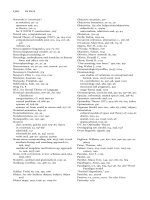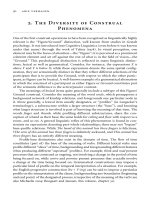The Oxford Handbook of Cognitive Linguistics Part 1 ppt
Bạn đang xem bản rút gọn của tài liệu. Xem và tải ngay bản đầy đủ của tài liệu tại đây (258.38 KB, 10 trang )
THE OXFORD HANDBOOK OF
COGNITIVE
LINGUISTICS
This page intentionally left blank
THE OXFORD HANDBOOK OF
COGNITIVE
LINGUISTICS
Edited by
DIRK GEERAERTS
AND HUBERT CUYCKENS
1
2007
1
Oxford University Press, Inc., publishes works that further
Oxford University’s objective of excellence
in research, scholarship, and education.
Oxford New York
Auckland Cape Town Dar es Salaam Hong Kong Karachi
Kuala Lumpur Madrid Melbourne Mexico City Nairobi
New Delhi Shanghai Taipei Toronto
With offices in
Argentina Austria Brazil Chile Czech Republic France Greece
Guatemala Hungary Italy Japan Poland Portugal Singapore
South Korea Switzerland Thailand Turkey Ukraine Vietnam
Copyright # 2007 by Oxford University Press, Inc.
Published by Oxford University Press, Inc.
198 Madison Avenue, New York, New York 10016
www.oup.com
Oxford is a registered trademark of Oxford University Press
All rights reserved. No part of this publication may be reproduced,
stored in a retrieval system, or transmitted, in any form or by any means,
electronic, mechanical, photocopying, recording, or otherwise,
without the prior permission of Oxford University Press.
Library of Congress Cataloging-in-Publication Data
The Oxford handbook of cognitive linguistics / edited by Dirk Geeraerts
and Hubert Cuyckens.
p. cm.
Includes bibliographical references and index.
ISBN 978-0-19-514378-2
1. Cognitive grammar. I. Geeraerts, Dirk, 1955– II. Cuyckens, H.
P165.O974 2007
415—dc22 2006051728
135798642
Printed in the United States of America
on acid-free paper
Preface
In the past decade, Cognitive Linguistics has developed into one of the most dy-
namic and attractive frameworks within theoretical and descriptive linguistics.
With about fifty chapters written by experts in the field, the Oxford Handbook of
Cognitive Linguistics intends to provide a comprehensive overview of the entire
domain of Cognitive Linguistics, from basic concepts to practical applications.
We thank the publisher, Oxford University Press, and its responsible editor,
Peter Ohlin, for the initiative they took to commission this reference work and for
the subsequent freedom they gave us in shaping it. The overall design and orga-
nization of the book, the selection of the topics to be treated, and the identification
of the experts to treat them, were predominantly the work of the first editor of this
volume, Dirk Geeraerts. The second editor, Hubert Cuyckens, was responsible for
the inevitably long and painstaking task of guiding the authors from the initial
versions of their texts, over numerous revisions on the content-side as well as on
the formal side, to the published versions.
At various moments in the course of this huge editorial task, Hubert received
help from Koen Plevoets, Hendrik De Smet, Gert De Sutter, Jose
´
Tummers, An
Van Linden, and Sofie Van Gijsel. We thank all of them for their generous support.
A special word of thanks also goes to Daniela Kolbe (University of Hannover) for
her meticulous help in formatting the references.
In addition, we particularly thank the authors for their chapters: if the Hand-
book achieves its goal of providing a uniquely wide-ranging and authoritative
coverage of the most significant topics and viewpoints in Cognitive Linguistics, it
will be through the professional and expert nature of the authors’ contributions.
This page intentionally left blank
Contents
1. Introducing Cognitive Linguistics, 3
Dirk Geeraerts and Hubert Cuyckens
Part I Basic Concepts
2. Embodiment and Experientialism, 25
Tim Rohrer
3. Construal and Perspectivization, 48
Arie Verhagen
4. Schematicity, 82
David Tuggy
5. Entrenchment, Salience, and Basic Levels, 117
Hans-J
¨
org Schmid
6. Polysemy, Prototypes, and Radial Categories, 139
Barbara Lewandowska-Tomaszczyk
7. Frames, Idealized Cognitive Models, and Domains, 170
Alan Cienki
8. Metaphor, 188
Joseph E. Grady
9. Image Schemas, 214
Todd Oakley
10. Metonymy, 236
Klaus-Uwe Panther and Linda L. Thornburg
11. Attention Phenomena, 264
Leonard Talmy
12. Force Dynamics, 294
Walter De Mulder
13. Spatial Semantics, 318
Jordan Zlatev
14. Mental Spaces, 351
Gilles Fauconnier
15. Conceptual Integration, 377
Mark Turner
16. Iconicity, 394
Willy Van Langendonck
Part II Models of Grammar
17. Cognitive Grammar, 421
Ronald W. Langacker
18. Construction Grammar, 463
William Croft
19. Word Grammar, 509
Richard Hudson
Part III Situating Cognitive Linguistics
20. Cognitive Linguistics and Functional Linguistics, 543
Jan Nuyts
21. Cognitive Linguistics and Autonomous Linguistics, 566
John R. Taylor
22. Cognitive Linguistics and the History of Linguistics, 589
Brigitte Nerlich and David D. Clarke
Part IV Linguistic Structure and Language Use
23. Phonology, 611
Geoff Nathan
viii contents
24. Inflectional Morphology, 632
Laura Janda
25. Word-Formation, 650
Friedrich Ungerer
26. Nominal Classification, 676
Gunter Senft
27. Idioms and Formulaic Language, 697
Raymond W. Gibbs, Jr.
28. Relational Constructions in Cognitive Linguistics, 726
Soteria Svorou
29. Clause Structure and Transitivity, 753
Jose
´
M. Garcı
´
a-Miguel
30. Complementation, 782
Michel Achard
31. Tense and Aspect, 803
Ronny Boogaart and Theo Janssen
32. Grammatical Voice in Cognitive Grammar, 829
Ricardo Maldonado
33. Modality in Cognitive Linguistics, 869
Tanja Mortelmans
34. Pronominal Anaphora, 890
Karen van Hoek
35. Discourse and Text Structure, 916
Ted Sanders and Wilbert Spooren
Part V Linguistic Variation and Change
36. Diachronic Linguistics, 945
Joan Bybee
37. Lexical Variation and Change, 988
Stefan Grondelaers, Dirk Speelman, and Dirk Geeraerts
contents ix









